How To Write Cross-sell Emails That Customers Cannot Resist
Once a customer has made a purchase, is it the end of your sales? Of course, it is not. The right approach can be just the beginning of a long-term relationship with many more purchases and even loyalty. It is what separates your business from “doing fine” to “crushing the eCommerce game”. Who knows, you may even buy a yacht if you do it right.
It also costs a lot less to make a satisfied customer buy again than trying to acquire a new one, so retention is incredibly important, and your email marketing plays a big part in this. The cross-sell emails are common and successful tactics that many marketers use in their email marketing strategy to increase the customer’s lifetime value and get extra sales with little costs.
This article will show you the way of writing cross-sell emails like a pro so customers can not resist buying more from your online store. You will learn what a cross-sell email is, how it works, when you can send it, real-life examples, actionable templates, and more.
Let’s get ready to sail on and catch some more customers!
What is a cross-sell email?
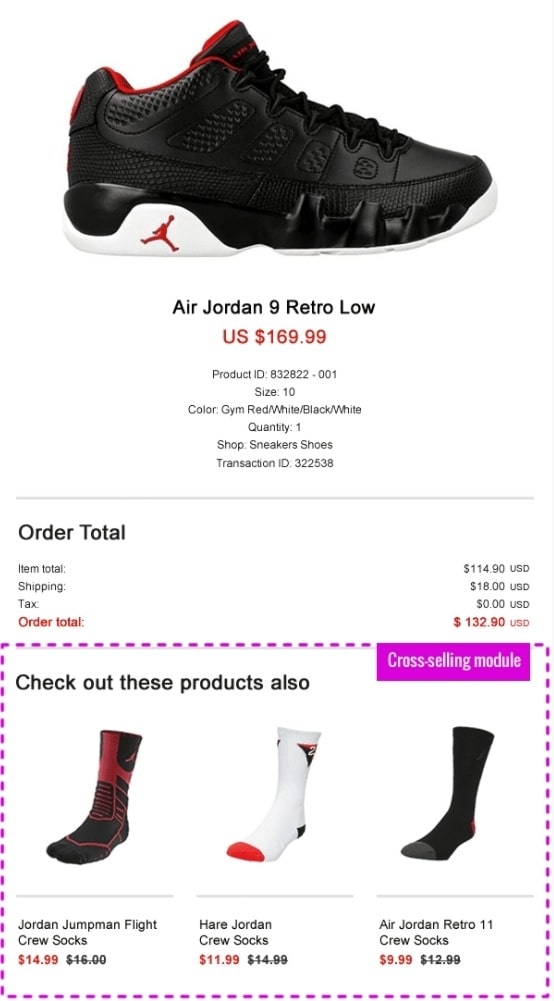
First, let’s see what is cross-selling. Cross-selling is a frequently-used sales method of offering customers additional products that can go well with what they have bought or have intentions to buy.
For example, if you bought from my store a pair of leather shoes at $120, I would ask if you would like to buy a super-awesome shoe cleanser for just $8.95. This is cross-selling in person. Instead of telling you about the complementary products, I will send you an email after you’ve bought a product with email marketing.
In this email, I can tell you that I thank you for purchasing, and show some items that would go really well with what you bought. I can also do this when you haven’t decided to buy the cart yet, showing you how you can increase your product’s value with just a few more items.
So, in general, cross-sell emails are emails that a business sends to customers that can recommend complementary products of their past purchases. This can be done in a single email or an email series. A cross-sell email’s goal is to make customers check out more products, and, eventually, purchase more.
Read more:
- 13+ Best Shopify Cross sell Apps
- All you need to know about Email Deliverability
- 10 Upsell Email Templates That Strongly Convince
Why should you use cross-sell emails?
Remember the example above of me selling you a shoe cleanser when you buy a pair of leather shoes? Even if I don’t successfully sell you the shoe cleanser, you already know more of my store’s products.
The same method can be seen in pretty much every industry. If you’ve ever bought a laptop, you are more likely to buy a laptop bag, a mouse, and an antivirus software. Then your cart already increases by a significant amount.
Cross-selling achieves two important things for a business:
- It increases the average order value of customers.
- It generates awareness about many more products or services that a store has.
And don’t think you are bothering your customers with more deals, because depending on your store’s layout, the customer’s buying time, and whether a buyer browses your store on a mobile or a desktop, consumers can actually miss many products that they are interested in.
According to Invespcro, cross-selling and product recommendations can contribute up to 35% of overall revenue for Amazon, while customers who click on recommended products are 4.5 times more likely to add that product into the cart.
That is how you get your yacht right there, by persuading customers that they can buy a better deal from your store. They get a more amazing experience with your product, while you can gain more revenue from them. If you do it right, you will build a relationship in which you recommend consumers more products and they would trust your recommendations. Both sides are happy, and you go happy sailing.
How do cross-sell emails work?

Loyal customers are people who enjoy your brand’s quality of service. These existing customers are more likely to open your offers than a prospective customer would. Not to mention, they already gave you a line of communication - their email addresses. If you can avoid the sales approach and have a real conversation with them in your emails, it will be easy to engage. If you want the existing customers to purchase more from your store, cross-sell emails can appeal directly to them and show how your products can benefit their lives.
Why do emails work well? Mainly because of an important rule that email marketers always remember: emails need to be relevant. Being relevant will be the difference between a successful cross-selling and a failed one.
If you can understand how your products relate to each other and how your customers feel about them, you can plan your cross-sell email series to show items that buyers are interested in. Your emails will then show what consumers consider relevant in one category, what is suitable for the same need, and what the customer’s taste is.
For example: a dog owner won’t look at the cat pages, while women who like high heels won’t take a look at sneakers. By having cross-sell email campaigns and monitoring the recipients’ interaction, you can understand their needs and give better recommendations through each email.
What makes an irresistible cross-sell email?
Timing and relevance are the key factors to create an irresistible cross-sell email. It has the product recommendations that are relevant to the customers and deliver the message at the right time.
By learning about the information customers are giving you – interests, browsing behavior, past orders, etc. – you can cater your cross-sell emails to their needs and preference, and only offer what they like. Targeting rules and filters can help as well, but we will get to that in the below sections.
In general, the key to make an irresistible cross-sell email campaign is delivering value with intelligence and good-timing messages, which will help to drive repeat purchase, while maintaining a relationship with the customers.
How can you send killer cross-sell emails that customers can’t resist
Now, let’s learn how to create effective cross-sell emails that customers will immediately feel like they want to buy more from you. There is no ultimate way, unfortunately, since your email approach would depend on your customer behavior, the items you sell, and how you set up the sales funnel. However, the next steps will give you a pretty good overview and how to get started.
Cross-sell emails strategies

A strategy is always necessary for any email campaign. There are four steps to plan your cross-sell email promotions:
1. Identify the opportunities to cross-sell.
First, let’s look at all your products and features, as well as mapping out the customer journey. If an item wants to be a strong candidate for cross-selling, it needs to be:
- In a similar category or usage
- Less expensive than the purchased item
- Useful and well-reviewed (Make the existing customers even more happy).
Remember the example in which you are buying a new laptop? The recommended products (mouse, laptop bag, antivirus program) are relevant, less expensive than the laptop, and will make your experience using the laptop even better. It is not cross-selling if you just throw in some random products and hope for a sale.
2. Choose the target persona
After you’ve picked some products with good cross-selling opportunities, you need to decide which customers you want to target. To do this, take a look at the customer journey, familiarize yourself with the buyer persona, and learn to read the psychographic segmentation data provided by your sales platforms.
Which segments will benefit the most from the cross-sell products? That is the question you need to answer. You should also look at which items consumers often purchase together, and who often do that. Selling a complimentary product will be easier when you can see that customers are already making those decisions.
3. Decide when to cross-sell
We have ‘what’ and ‘who’, now, let’s decide on ‘when’. Using the analytic on purchase behavior of your customers, can you identify the time that two items are often bought together. The time can be the result of many events, which happen during the customer journey, such as:
- When a customer purchases something in a new category, which means they have a new interest
- When a customer purchases and leaves a positive review.
- When a customer passes her/his typical buying frequency period.
The map above shows how cross-selling, combined with upselling, is an ongoing effort to expand the relationship with customers.
4. Determine your messages and positioning
The final piece of the puzzle is how you represent the cross-sell. What benefit do the complementary products have on their own, and also in combination with the purchased item. You need to answer why they are a good match. Are there any user cases or benefits that are especially intriguing to your target customers?
Another way to boost your message is to include social proof. By seeing how other buyers feel satisfied with the add-on products, customers will feel more confident to add them into the carts. Ensure that your value is clearly shown so customers can make a decision on their own.
Cross-sell emails subject lines
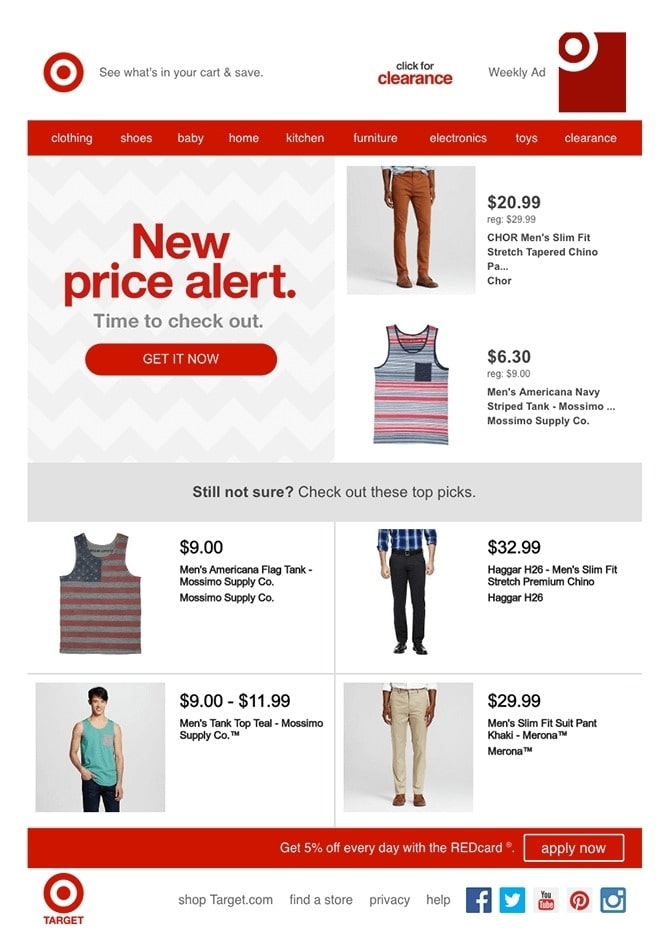
You don’t want to overwhelm your customers with overused lines like “You may also like…”. There are many opportunities and techniques to use, so it is important you figure out which kind of subject lines that can touch customers.
When sitting down to work on the subject lines for your cross-sell email campaigns, you want to make sure that your time is spent on making the most effective option possible. To do this, you should follow these subject lines’ best practices:
- Keep the subject lines short, sweet, and straight to the point.
- Test your subject lines with co-workers before sending them.
- Avoid using all caps, or even title case
- Personalization is the key to stand out in a crowded inbox
- Generate excitement or urgency is a good way to get readers to act
- Emojis can be your friends if they are used correctly, so don’t be afraid to test them.
There are many ways to introduce the customers to the complementary products, and you should get creative with it. Try writing something like “Here is a collection you may like” or “You will love these picks to go with [product’s name]”. I will show you more examples and templates below, but, for now, come up with some of your own subject lines first. After all, you understand your audience best!
Cross-sell emails’ best time to send
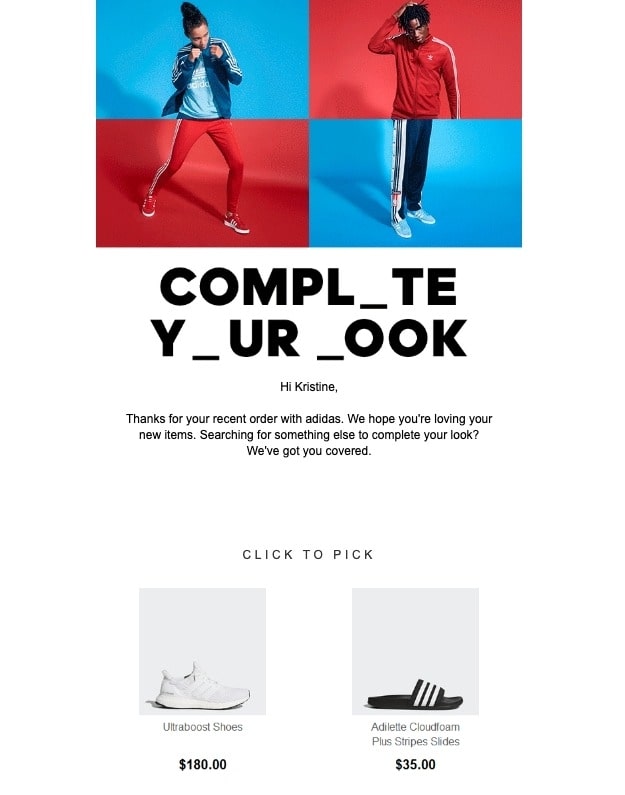
How you set up the sale funnel and your target audience’s preference will play a big part in deciding the time to send cross-sell emails. For example: if your store’s average purchase frequency is long (30+ days), then cross-selling right after the customer has checked out or received the item won’t be very beneficial. The low purchase frequency will lead to a low conversion rate.
In this situation, you can think of sending cross-sell emails immediately when a customer finishes ordering, showing which items are complementary to the current order (maybe including an incentive will push them to add the items). And if your customers order more frequently, you can send more cross-sell emails after the previous orders in just 24 hours.
Your delivery time and fee will also affect your cross-sell emails’ timing (before or after delivery). You may want to try cross-selling by offering free delivery for a certain amount of cart worth to see if that can increase your conversion rate. Chances are you will have to test many email types to find what works best.
Try to calculate the time between orders of correlated products among customers. This will help you understand the natural purchasing cycle of your buyers and when they often place the second order. That way, you can create a data-backed decision on when to send cross-sell emails.
Cross-sell email real-life examples
There are many ways that you can cross-sell through email marketing, and it can happen at various stages of the customer journey. Let’s see some real-life examples from other businesses to see how they send cross-sell emails to drive more revenue.
Dollar Shave Club
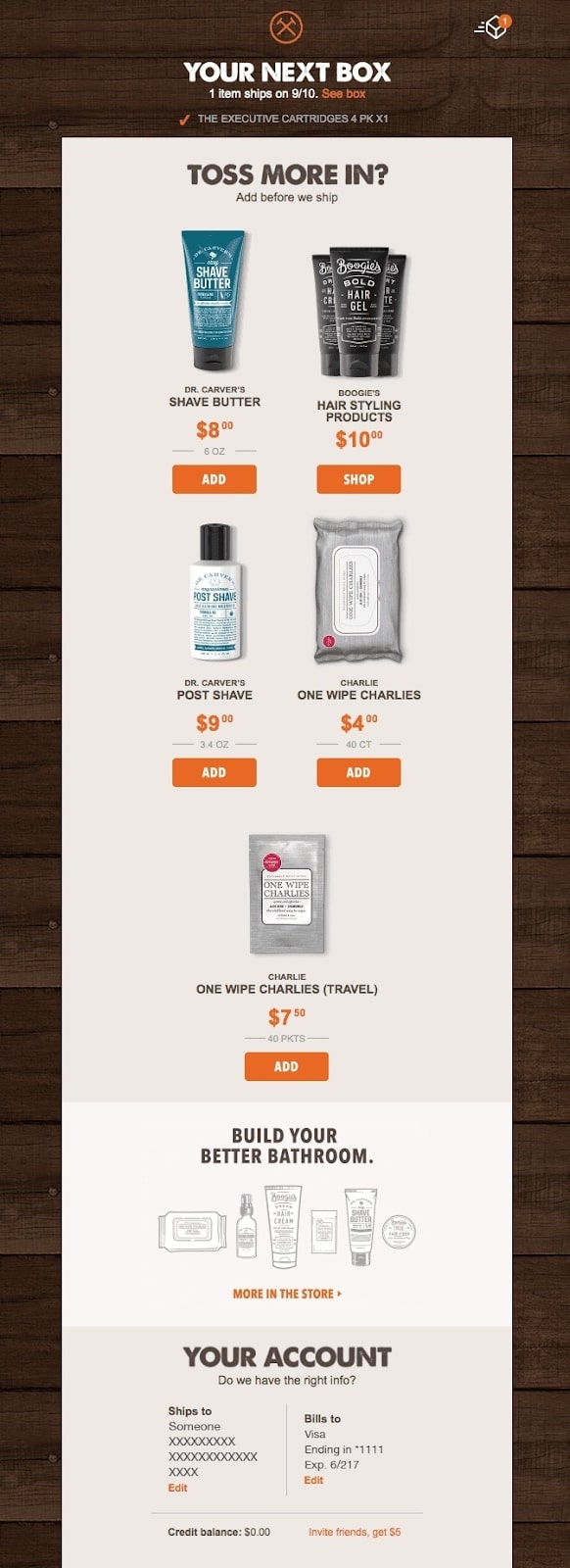
The most common analogy of cross-selling that you must have come across is: “Would you like some fries with that?” (McDonald). Based on the same method, Dollar Shave Club plays it out in their emails beautifully, with a touch of the brand’s personality.
The cross-sell email above presents inexpensive items that are complementary to the main purchase. For a razor, a cross-sell is a post-shave cream and a shave butter. The cross-selling items are portrayed as a smaller commitment, signalized by the playful headline: “Toss more in?”.
If you are a SaaS (Software As A Service) company, you can learn from this by adding more standalone features to the cross-sell emails that complement the customer’s current app, or integrating with third-party tools. Look how the email also specifies the shipping date of the order, adding urgency to the cross-sell.
A less conventional way of cross-selling is asking customers to buy a new product and immediately cross-sell them with other products that complement the core product.
Dollar Shaving Club provides another example, in the email below which shows a newly bought travel bag and then suggest items customers can buy to fill the bag:

I like this because the whole point of buying a travel bag is to keep your items inside. Consumers will need to buy shaving cream, moisturizer, etc., for their travel, so why not buy it all from one place?
Ralph Lauren

Another method of sending cross-sell emails that is less used is abandoned cart’s cross-selling. This is when the customer adds products to their carts but fails to purchase. The business then sends an abandoned cart email combined with cross-sell items to increase the cart’s value.
A good example of this is emails by Ralph Lauren. They email customers and let them know they can still order the pullovers left in the cart. In the footer of the email, there are less expensive boxers and socks that the customer may also like. The customer already placed a men’s clothing product in the cart, which shows that the customer is a man or is shopping for men products. So Ralph Lauren cross-sells relevant men-related items, which is perfect.
Best Buy

Another popular cross-sell method for email marketing is the after-sale email. This is when you send an email providing the accessories for the purchased item.
In the email example above, Best Buy recommends a number of related products for a customer’s new camera. The email is simple and shows all the relevant product categories associated with the purchased item. This is pretty much like when you buy a laptop in the store, the accessories give a better user experience.
Mailchimp
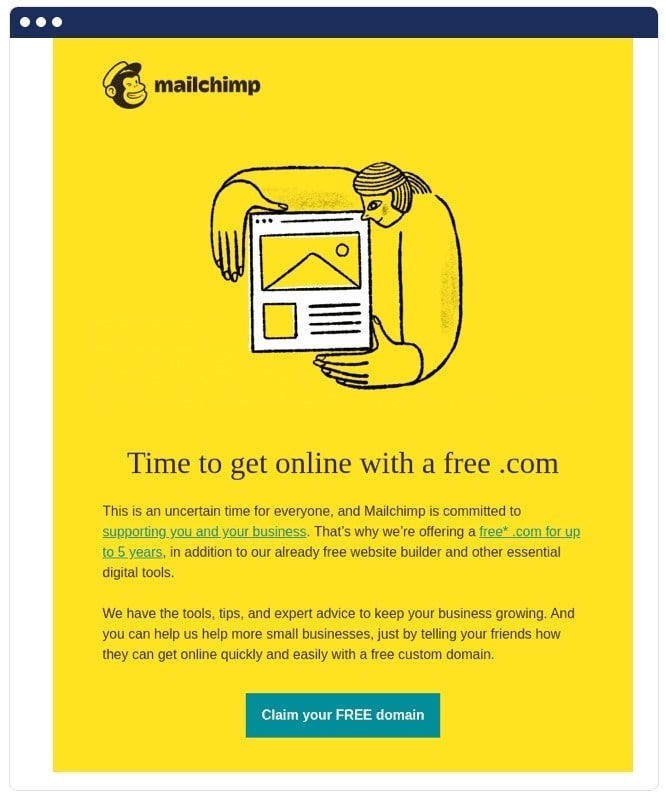
If you sell online software, then this example is for you. While Mailchimp’s cross-selling offer is basically free, it is still great to keep users more loyal. As customers use more of your service and build a deeper connection, they are more likely to stick around with your company.
Mailchimp sends a cross-sell promotion email that gives recipients a free .com domain. In the future, they may consider upgrading this offer to a standard cross-sell and sell the domain at a certain price. More than that, the email is also beneficial to the company, since it asks readers to tell their friends and win a free domain. By receiving something for free, customers help Mailchimp be known by more people.
All of these cross-sell email examples follow the same principles: they show relevant cross-sells items that are complementary to the core product a customer is ordering or already has.
Cross-sell email templates to engage with customers
In this section, I will show you 2 cross-sell email templates from AVADA Email Marketing tool. There are two options of cross-sell email campaigns that you can choose from: Cross-sell 1 email and Cross-sell 3 emails. The 3 emails option is a pre-made series that will help you create a cross-selling tactic quickly. If you install the app now, you can immediately use the templates without making it again from scratch.
Cross-sell 1 email template

In this template, you will be able to start a campaign after the customer has purchased. The auto wait time is one day after the purchase, and the default subject line for the email is “You will love these too!”.
This is just the start, because while your email may have the right copy, your offer will never draw any attention without an eye-catching design. In AVADA’s email builder, you can drag and drop items, add your logo, change the copy, and more! The work flow is also easy to set up, giving you full control over when to send the email.
Cross-sell 3 emails template
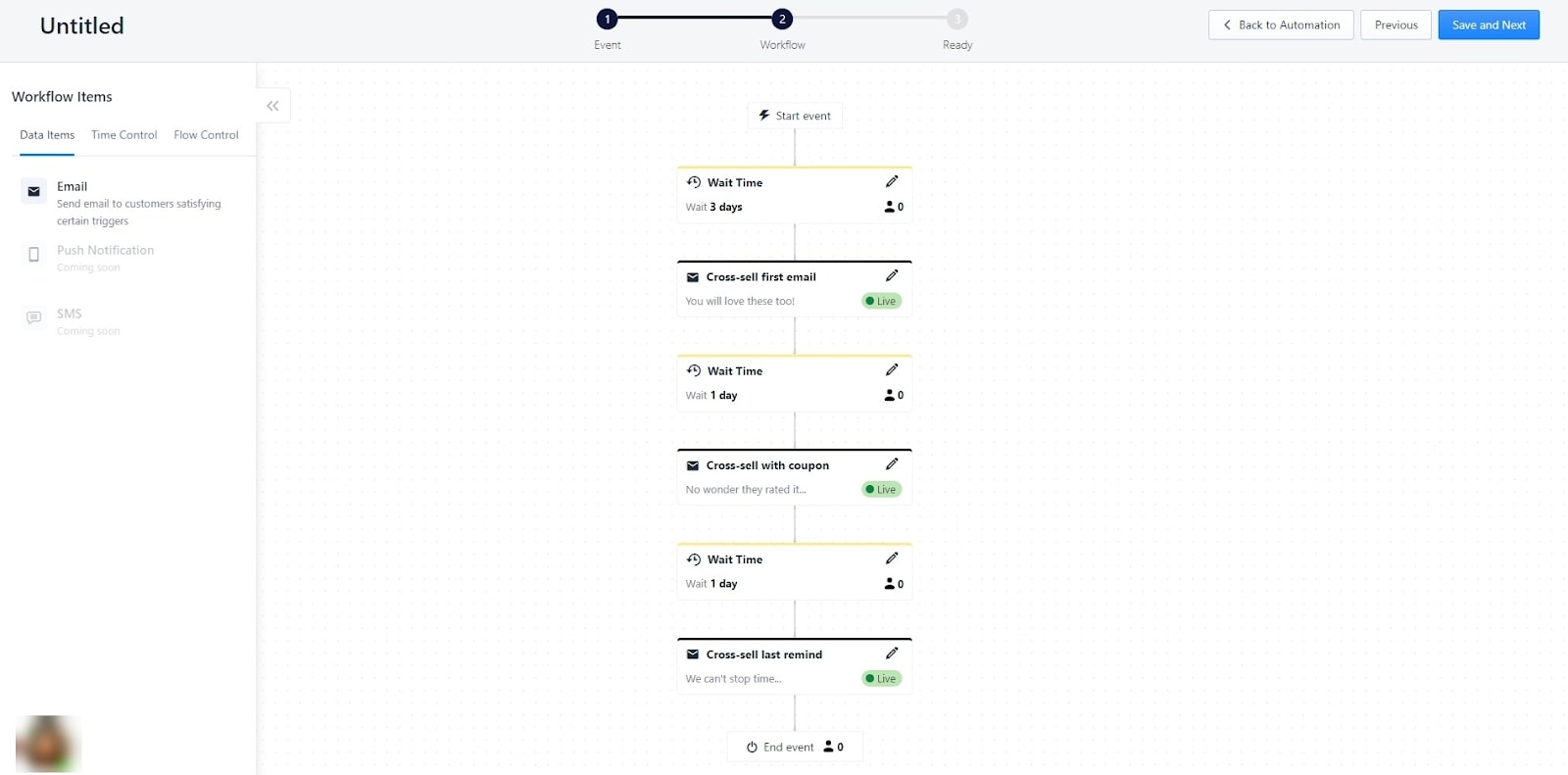
In the 3 emails template, you will see a pre-made email series specifically made for cross-selling. This series is often used for stores with a longer purchase frequency, so you can connect with customers slowly and make sure to not bother them with deals too soon. Three emails are also the golden number to hit-or-miss, you either plant enough buying intention into the customer’s mind, or simply give up and try another campaign.
With this template, you will have the default sending’s wait time of 3 days, 1 day, and 1 day. The first email will show the complementary items, while the second email shows social proof of the cross-sell items, and the third email adds a sense of urgency into the deal.
Just like with the 1 email template, you can fully customize the email and the workflow - with visibility of all the action steps, logic, and email content. Feel free to build your own cross-sell email sequence, while adjusting the sending time for your customers’ preference.
Hit the link below to check out AVADA Email Marketing and install the app now, it is free!
Get AVADA Email Marketing FREE
Related posts:
- How to Create an Email Signature in Gmail?
- How Long Should A Cover Letter Be?
- What is the Foot-in-the-door Technique?
- 12 Mental Triggers in Email Marketing
Last words
You are now ready to write cross-sell emails that customers cannot resist and want to buy more. But, slow down, because many business owners see dollar signs in their eyeballs and start cross-selling everything. You don’t want to do that, it will take a lot of time and even is not profitable. Instead, use the top-down approach to cross-sell your products.
Depending on your eCommerce business’s size and the email list, select about the top 15 products in your store to do cross-selling. Create cross-sell email for each item, then start measuring the performance, tweaking the copy, and testing the number of relevant items in the emails. Once you see a positive ROI, you can repeat the process.
That is all, thanks for reading. If you have any questions, leave them in the comment section, and don’t forget to check out our AVADA AVADA Abandoned Cart Recovery!
New Posts







